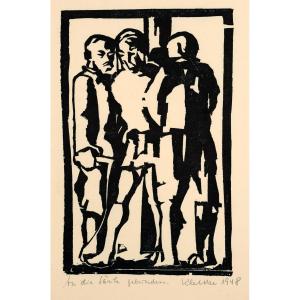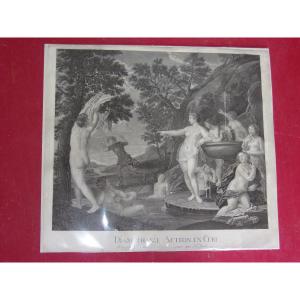- Slight traces of creasing in the lower margin, otherwise in excellent condition with a strong impression.
- Concise congeniality -
Alfred Rethel's drawing, cut into wood by Oskar Bangemann, is in the Dresden Kupferstichkabinett. Even before Rethel struck the artistic nerve of his time with his own series of woodcuts, "Auch ein Totentanz" (1848), he had already explored the theme of the dance of death, studying in particular the graphic Dance of Death by Hans Holbein the Younger and its new edition by Nikolaus Daniel Chodowiecki. The master of the house, torn from life by death, is obviously an aristocratic ruler with a wig and ermine-trimmed coat, while the collapsed man is supported by a bourgeois with a fallen top hat. Death thus also illustrates a socio-political turning point in the context of an Italian Renaissance scene. Oskar Bangemann, who was head of the woodcut class at the Berlin Museum of Decorative Arts from 1924 to 1942 and taught at the Berlin Academy of Fine Arts, was a master of the woodcut technique. He transformed Rethel's pale pencil drawing into an expressive shade of red. The result is an "all-over" of lines reminiscent of Albrecht Dürer's woodcuts, from which the dramatic scene of sudden death emerges again and again. About the artist The talented Alfred Rethel began his studies at the Düsseldorf Art Academy in 1829 at the age of thirteen. His teachers, Heinrich Christoph Kolbe and Wilhelm Schadow, followed a classical Nazarene style, while Carl Friedrich Lessing, who also worked in Düsseldorf, introduced Rethel to history painting, which had a formative influence on him. In 1836 Rethel went to the Städelsche Kunstinstitut in Frankfurt, which was directed by Philipp Veit. In Frankfurt he received the prestigious commission to fresco the Kaisersaal of the Römer with portraits of rulers, and he also won the competition to paint the Coronation Hall of the Aachen City Hall with scenes from the life of Charlemagne. After creating the illustrations for the "Nibelungenlied" (1840/41) and the watercolor cycle "Der Zug Hannibals über die Alpen" (1842-1844), Rethel traveled to Rome in 1844. There he studied the art of Raphael and associated with the "German Romans". Upon his return, he moved to Dresden and in 1847 began work on the Charlemagne frescoes for the Aachen City Hall. In 1848 Rethel created the woodcut series "Auch ein Totentanz" (Also a Dance of Death), which made him one of the most famous artists of his time. Demand was so great that the series was reprinted in an edition of 10,000 copies, which was unusual for the time. From 1852 to 1853, Rethel was again in Italy, where his mental state became increasingly cloudy. The resulting illness led to his early death at the age of 43.




























 Le Magazine de PROANTIC
Le Magazine de PROANTIC TRÉSORS Magazine
TRÉSORS Magazine Rivista Artiquariato
Rivista Artiquariato